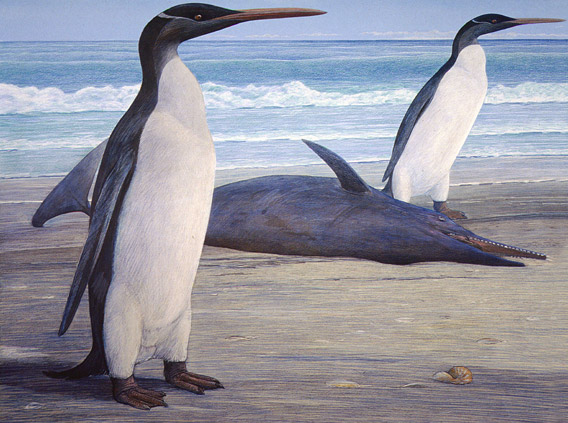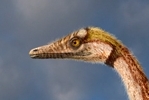
Two Kairuku penguins come ashore, passing a stranded Waipatia dolphin. Artwork by Chris Gaskin, owner and copyright owner: Geology Museum, University of Otago..
Around 25 million years ago a penguin with a long, sharp beak and massive flippers lived in a New Zealand that was almost entirely underwater. The bird, named Kairuku after a Maori word that means “diver who returns with food,” was first discovered in 1977, but has only recently been reconstructed by scientists in a study in the Journal of Vertebrate Paleontology.
“Kairuku was an elegant bird by penguin standards, with a slender body and long flippers, but short, thick legs and feet,” explains co-author Dan Ksepka with North Carolina State University in a press release. “If we had done a reconstruction by extrapolating from the length of its flippers, it would have stood over 6 feet tall. In reality, Kairuku was around 4-feet-2 inches tall or so.”
Kairuku was the biggest of five penguins species known from New Zealand at the time.
“The location was great for penguins in terms of both food and safety,” says Ksepka. “Most of New Zealand was underwater at that time, leaving isolated, rocky land masses that kept the penguins safe from potential predators and provided them with a plentiful food supply.”
Today, New Zealand and surrounding islands are still a hotspot for penguins, sporting six species. Unfortunately penguins worldwide are in crisis: over 60 percent of the world’s penguins (18 species) are currently threatened with extinction according to the IUCN Red List. Scientists believe that overfishing has decimated penguin prey populations, causing many of the flightless birds’ populations to decline. In addition, researchers worry that climate change is putting additional pressure on penguins.
Related articles
Jurassic insect sings again
(02/06/2012) Innovative research has made a long-extinct katydid—which inhabited the world of dinosaurs like stegosaurus, allosaurus, and diplodocus—sing again. The discovery of an incredibly well-preserved fossil of a new species of katydid, dubbed Archaboilus musicus, gave biomechanical experts the opportunity to recreate a song not heard in 165 million years according to new research published in the Proceedings of the National Academy of Sciences (PNAS).
Scientists discover giant species of crocodile; luckily it is extinct
(09/15/2011) Researchers excavating a coal mine in Colombia have discovered a previously unknown species of prehistoric crocodile. The beast is described in the September 15 issue of the journal Palaeontology.
Picture: scientists identify first known single-fingered dinosaur

(01/25/2011) Paleontologists working in China have discovered a first for dinosaurs: a species with only one finger. Named Linhenykus monodactylus, the extinct species stood only about two feet high and weighed about as much as a large parrot. Although small, the new dinosaur was a member of the carnivorous therapod dinosaurs, which include the infamous Tyrannosaurus Rex. The find was announced in the Proceedings of the National Academy of Sciences.